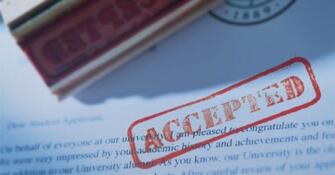
Guaranteeing admission to state universities makes it more likely that academically talented, low-income students will choose colleges that are challenging enough to match their abilities, a new study has found.
The new research focuses on a problem that’s bedeviled educators and researchers: the tendency of low-income students to “undermatch,” or pick colleges that are too easy for them. 69��ý from low-income households are much more likely to undermatch than wealthier students.
Previous studies have suggested that a lack of information about options, and doubts about the ability to afford college, contribute to undermatching. The new study adds a twist: the possibility that certainty of admission could help reduce those barriers.
, the study found that guaranteed admission boosted by 24 percentage points the chance that low-income students would apply to a school that matched their talents, compared to a 15-point gain for wealthier students.
Researchers Kalena E. Cortes, of Texas A&M University, and Jane Arnold Lincove, from the University of Maryland, studied a Texas policy that guarantees state university admission to the top 10 percent of students in each of its high school’s graduating classes. They examined college matching among 146,000 students who graduated from public high schools in Texas in 2008 and 2009 and applied to at least one public university there.
That policy has changed a bit since it began in 1997 as a bid to diversify college campuses. In 2011, the system’s flagship campus at Austin began offering automatic admission only to the top 7 percent of each class, and plans to cut that back to the top 6 percent next year.
But during the period the researchers studied, admissions were guaranteed to the top 10 percent of students at all University of Texas campuses. To examine the matching dynamics, they identified a group of students who had high SAT scores and top-10-percent class rank, and sorted them by household income.
They found that low-income students were still more likely than wealthier students to undermatch, but the effect of guaranteed admission was much bigger on them than on their more-affluent peers.
See also:
The researchers found, for instance, that with guaranteed admission, low-income students were 22 percentage points more likely to apply to a flagship campus, while wealthier students were 16 points more likely to do so.
The same dynamics played out when the researchers studied enrollment patterns. They found that guaranteed admission created a 17-percentage-point reduction in the chance that higher-income students would choose a “safety” school (typically an easier-to-get-into alternative). For low-income students, guaranteed admission reduced the chance of choosing a “safety” school by 23 percentage points.
The guaranteed-admission effect faded, however, if low-income students were not also highly qualified. The researchers found no significant differences in application and enrollment patterns for low-income students who did not have high SAT scores.
Cortes and Lincove theorized that this could be because low-income students are more likely than wealthier students to interpret lower SAT scores as a sign of their college qualifications, and that could influence their college choices.
Image: Getty
